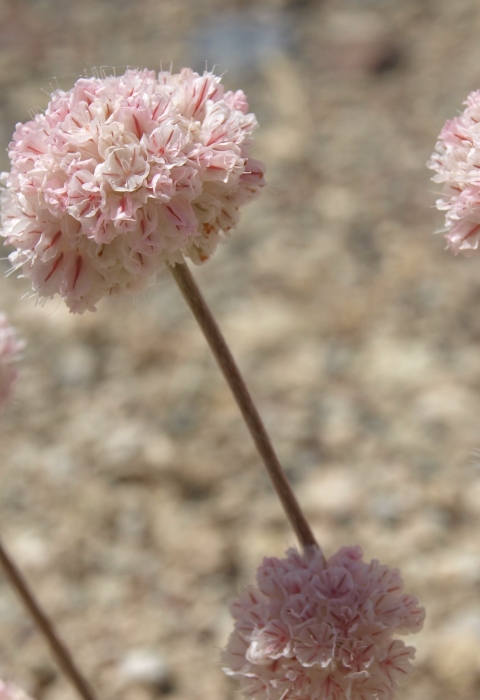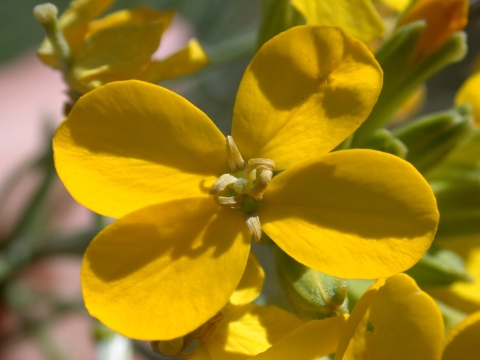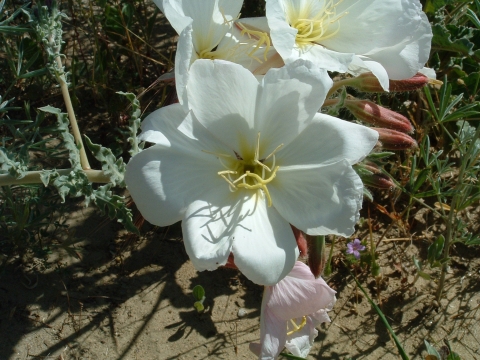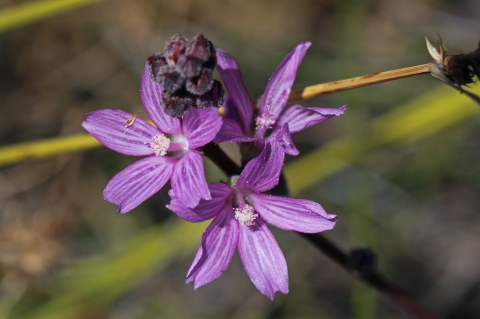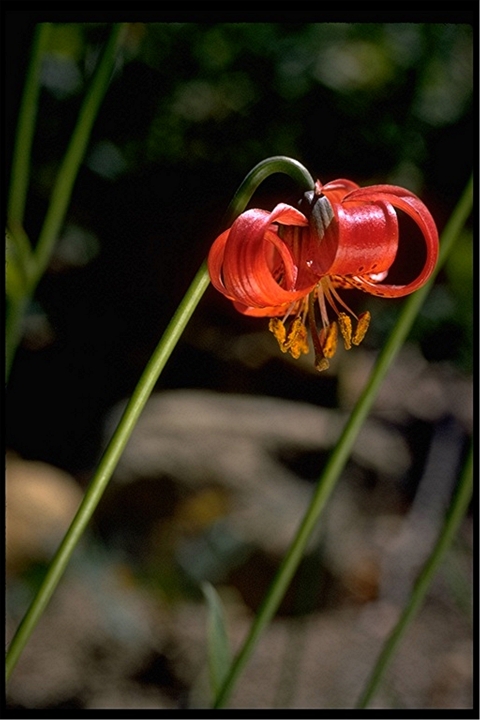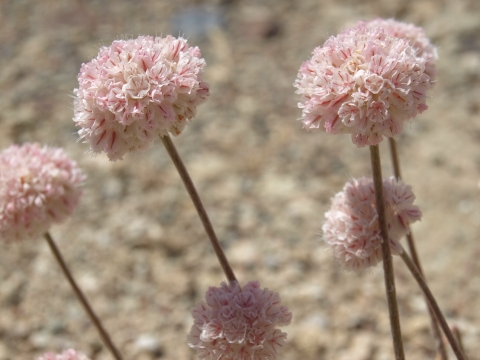We’ve all heard the saying, “April showers bring May flowers,” but at the U.S. Fish and Wildlife Service, we like to say, “listed flowers are the prettiest.” Here’s a few threatened and endangered flowers in California and Nevada that we think prove our point.
Kenwood Marsh Checkermallow
If you only wear pink on Wednesdays, you can’t be in the Kenwood Marsh checkermallow’s club. This flower wears pink every day. Sporting a cone-shaped grouping of tiny, hot pink flowers, this rare beauty (also known as the Kenwood Marsh checkerbloom) is endangered and only found in two locations — Kenwood Marsh and Knight’s Valley — both in Sonoma County, California. Growing to a height of 4 feet, the flower blooms from late June to September. Plant numbers have decreased over the years for a number of reasons, including ongoing drought and water diversions that remove water from the marshes that the flower calls home. Thankfully, Deerfield Ranch Winery, owner of the Kenwood Marsh property, has partnered with USDA’s National Resources Conservation Services and the U.S. Fish and Wildlife Service to restore the marsh and protect and expand the population of the endangered flower.
Contra Costa Wallflower
You can’t be a wallflower while wearing orange… even if it is the new black.A member of the mustard family, the Contra Costa wallflower’s four orange petals are each less than an inch long, but the plant can grow over 9 feet tall. Wallflowers earn their name through their uncommon ability to thrive in places like sand dunes, rock crevices, and even stone walls. The Contra Costa wallflower is mainly found at Antioch Dunes National Wildlife Refuge, which was once part of a sand dune system 120 feet tall and 2 miles long. The flower often grows on north-facing slopes and shaded locations at Antioch Dunes, likely because the scarce surface moisture lasts longer with less sunlight. The population of the endangered flower declined after the dunes were depleted to make bricks to rebuild San Francisco following the devastating earthquake of 1906.
Western Lily
Tall, attractive, charismatic… Yes, we’re talking about the western lily. Reaching heights of over 6 feet, this beautiful flower catches the eye of birds and bees, and people. Primarily pollinated by hummingbirds, the western lily has bright, star shaped red flowers with yellow centers. Discovered in the late 19th century, the lily fell victim to over-collecting, and populations declined to the point where it was listed as an endangered species in 1994. Today, the lily is only found in a narrow strip of land along the Pacific Coast between Coos Bay, Oregon, and Eureka, California. Thankfully, biologists from many agencies and volunteers are collaborating to restore habitat for the lily and recover its populations.
Antioch Dunes Evening Primrose
The Antioch Dunes evening primrose is open all night long, but not because it can’t sleep. By opening its flowers late in the afternoon and closing them in the morning, the primrose attracts pollinators that also prefer nighttime, like large moths. Each 2-3-inch-wide flower has four pink or white, heart-shaped petals with yellow stamens in the middle. The plant can reach 2.5 feet in height, and during the winter months, its stems dry and curl upward around its seed pod, creating a woody structure structure
Something temporarily or permanently constructed, built, or placed; and constructed of natural or manufactured parts including, but not limited to, a building, shed, cabin, porch, bridge, walkway, stair steps, sign, landing, platform, dock, rack, fence, telecommunication device, antennae, fish cleaning table, satellite dish/mount, or well head.
Learn more about structure that looks like a birdcage. The Antioch Dunes evening primrose has responded well to recent sand dune restoration at Antioch Dunes National Wildlife Refuge in California, where the plant is mainly found. If the trend continues, the Service may be able to change the endangered flower’s status to threatened.
Pedate Checker-mallow
Big Bear Valley in the San Bernardino Mountains is a popular tourist attraction for winter skiing and summer boating. But the area’s year-round residents provide the true color, like the federally endangered Pedate checker-mallow. With flowers varying in color from pink to magenta, the checker-mallow flaunts its colors along the edges of high-mountain meadows. Plants grow between 7-16 inches high and bloom between May and August. Development of homes, businesses, and water resources has led to the plant’s decline, and there are currently 16 known occurrences. Thankfully, the California Department of Fish and Wildlife, the San Bernardino National Forest, and the San Bernardino Land Trust are carefully managing lands where some of the flowers are found and working to recover the species.
Pitkin Marsh Lily
If you’re a fan of lilies, the Pitkin Marsh lily will surely win your heart, but don’t take it home with you. Found in Sonoma County, California, this endangered plant can grow to be 6 feet tall. Large, dark orange blossoms arrive from June through July, but seeing one will be a challenge. They are only found in freshwater marshes and wet meadows, and most known occurrences of the flower are on private land. The lily has dwindled in numbers over the years due to several reasons, including humans collecting the plants, seeds, and bulbs for household and horticultural use. The Service is working to educate the public on illegal collection of listed plants in the hope of keeping this beautiful lily part of our ecosystem.
Steamboat Buckwheat
Did somebody say hot springs? Steamboat buckwheat is all in. Found only in the Steamboat Hills area of southern Washoe County in Nevada, the Steamboat buckwheat only grows in the soil and substrates left behind by old thermal spring flows. With tiny white and pink flowers forming the shape of a pom-pom, the plant is listed as endangered at both the state and federal levels due to geothermal development that has reduced the flow of spring water to its habitat. Additionally, non-native plants are crashing this thermal spring flow habitat party, making life more difficult for the buckwheat. Scientists are monitoring populations of the buckwheat and working with partners to ensure its continued presence in this special landscape.
Yreka Phlox
This phlower fits into the “rugged” fauna category. In the foothills of Siskiyou County, near Yreka, California, Yreka phlox thrives in harsh soil conditions among rocks rich in magnesium and iron. The endangered plant produces brilliant splashes of deep pink to white-pink blooms in April and May. Thankfully, some know beauty when they see it. In 2009, the city of Yreka adopted the phlox as its official flower. Today, the Service is working with several partners, from local governments to the timber industry, to preserve and protect habitat and reduce threats to the small plant.
What is the service doing
The Service is working with a number of partners to improve habitat and remove threats to these flowers. Our goal is to help them recover to the point where they can be delisted. And if they are delisted, we’ll continue to rank them among the prettiest flowers in the West.
